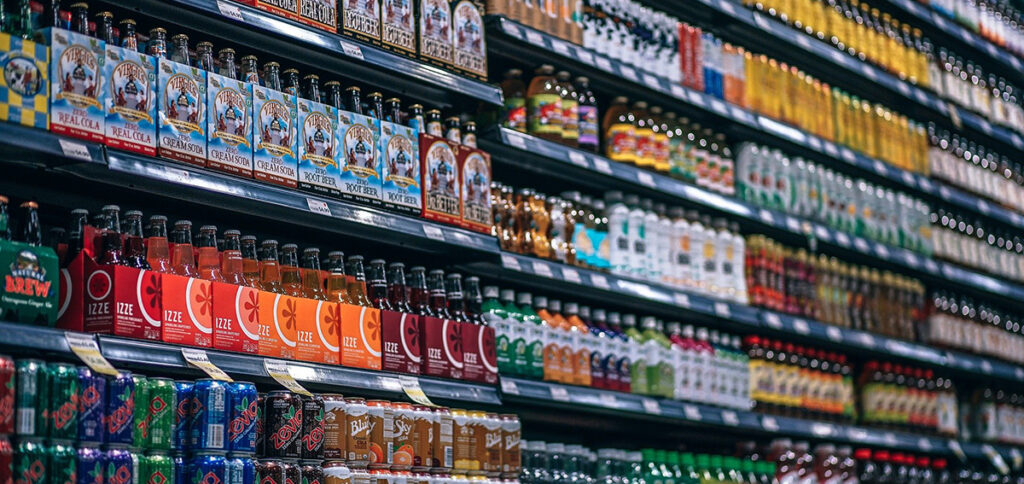Varied developments in the beverage industry

In 2019, the demand for non-alcoholic beverages fell by 5.8 percent per household, causing several market observers to hope for stabilization in 2020. The changes, however, to everyday life due to COVID-19 measures have also shaped developments in the beverage industry.
COVID-19-related measures have impacted the market for both alcoholic and non-alcoholic beverages: Food products benefited from people eating at home rather than eating out in the first eight months of 2020 with an above-average increase of 14 percent. In contrast, the consumption of non-alcoholic beverages fell behind overall market trends with a growth of only 6.7 percent compared to the previous year and a decrease of one percent in volume demand. One reason for the declining volume demand of non-alcoholic beverages is that June and July were colder than the previous year. This can be partly offset by a positive trend in August.
Household consumption is increasing
This trend in the non-alcoholic beverage industry demonstrates wildly different tendencies this year. Some categories in retail grocery stores have been able to benefit from the changes in consumer behavior since the start of the coronavirus crisis, while others have not. In previous years, smoothies were an area of growth for fruity beverages, while the consumption of classic fruit juices and nectars was on the decline. But, due to reduced consumption outside of the house and people having breakfast and lunch at home, smoothies are in decline by 10.7 percent, while fruit juices and nectars enjoyed an increase of around 7 percent. Segments with a strong position in the out-of-house market are currently even showing an above-average growth. Cola and cola-mix drinks have increased by 6 percent and energy drinks by 23 percent in household consumption. Bitters are also enjoying a surge in popularity as consumers aim to recreate the long drink feel from the bar at home.
New free time behavior is changing consumption
However, not all non-alcoholic beverages are winners. Soft drink categories such as mineral water, spritzers or flavored waters, and sports drinks are listed among the losers. On one hand, the reasons to consume these products, such as (team) sports activities, are missing due to the lockdown and the drastic changes to free-time behavior. On the other hand, competitive segments for non-alcoholic beverages have developed in a very dynamic way in recent months.
The hole left by out-of-house consumption has strongly encouraged domestic demand in retail grocery stores, meaning the household consumption for the entire FMCG area showed a 12.5-percent increase in sales in Germany by August 2020.
As an alternative to mineral water, an increasing trend is emerging in the demand for soda maker cartridges. This has been significantly fueled by both the entry of Aldi Süd into the market last year and the increasing availability of replacement cartridges in other stores. In addition to these reasons why consumers are increasingly switching to soda makers, the general attempts at one-stop-shopping and fast, uncomplicated stockpiling at the start of the pandemic also certainly contributed to this rapid growth.
Drink syrups are enjoying an extreme rise in popularity and, even within the entire FMCG range, are one of the fastest growing categories. Interestingly, this growth dynamic first began a few weeks after the initial wave of panic buying, which primarily served to secure basic commodities. Subsequently, products were increasingly bought to replace visits to restaurants or for experimentation, such as with self-mixed cocktails.
Further developments in the beverage industry
The demand for alcoholic drinks is also showing signs of shifting to the home setting. However, nowhere was sales growth in the first half of 2020 stronger than in the overall market development of FMCG. Specifically, this includes the product groups of wine (plus 20.2 percent) and spirits (plus 14.9 percent), which are in higher demand. Beer remains somewhat behind this beverage industry trend with an increase of 8.1 percent.
A snapshot of the development of packaging in the beer market shows that the trend towards cans is still strong. Cans were also able to extend in the consumer range again in the first half of 2020 and have since reached 13.4 percent of all households in Germany. The increased shift of out-of-house consumption into the home setting has also led to significant growth in bulk packs of 0.5-liter and 0.33-liter returnable crates. This is a new development and certainly must be viewed in the context of the coronavirus crisis. How long this special development will last remains to be seen.
Even if COVID-19 is an omnipresent topic for manufacturers and consumers for the time being, sustainability and climate protection remain highly relevant, particularly to consumers. For non-alcoholic drinks, the packaging trends of recent years, for example, have continued: PET packaging is on the decline, while glass containers were able to grow significantly by more than 12 percent.

Would you like to share your developments and innovations in the beverage industry with an international audience? Then we invite you to participate in the next drinktec, which will be held in Munich from September 12 to 16, 2022.
This article is powered by Verlag W. Sachon.
